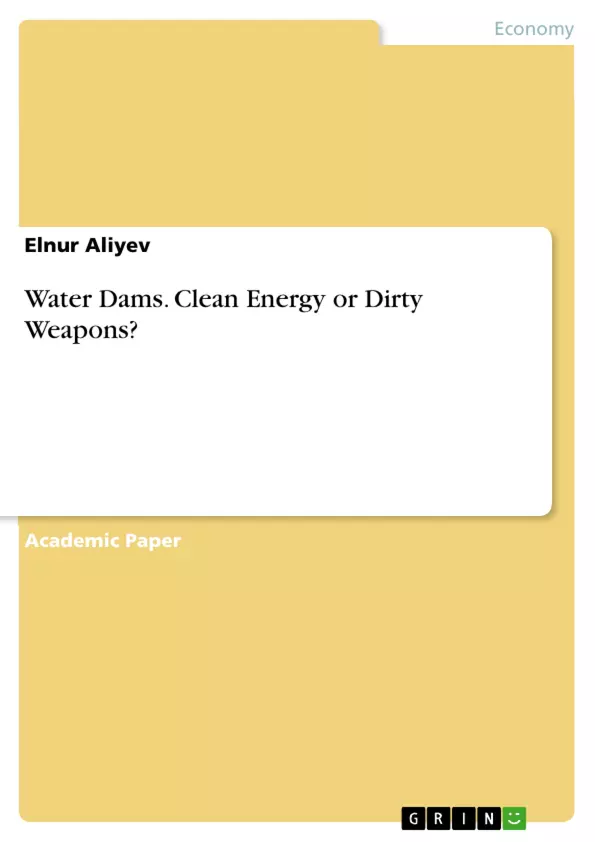The present paper analysed both sides of the spectrum by looking at two prominent and controversial dam projects – Three Gorges Dam of China and Grand Ethiopian Renaissance Dam of Ethiopia, as well as mentioning some small-scale reservoir cases within the topic. Together with the technology development, population and economic growth and an increasing global responsibility to produce energy sustainably, water dams have become milestone projects throughout the world. However, with the expanding number and scale of hydro-power infrastructures, undesired negative effects such as population resettlement, loss of habitat and probability of water wars have also arisen.
In a world increasingly characterized by numerous concerns over global challenges such as climate change, food security and environmental sustainability, one resource is a key more than ever – water. Despite its irreplaceable survival value for life in general, water resources accompany social development and economic growth as a major contributing element. Among multiple functions of water resources for humanity, one of the popular services that is increasingly critical is electricity generation that is realized through various-scale water dam infrastructures. Even in the current global pandemic situation, hydropower is and is forecasted to remain as the largest renewable power generation type through 2025. The significance of water dams is further emphasized in the light of UN 2030 Agenda because harnessing water power is widely contributing towards achievement of targets such as decarbonisation, access to clean electricity and food security globally.
Inhaltsverzeichnis (Table of Contents)
- Water Dams: Clean Energy or Dirty Weapons?
- Case Studies
- Three Gorges Dam, China: The Mega-Dam With Mega-Risks
- Benefits
- Concerns
- The Grand Ethiopian Renaissance Dam (GERD), Ethiopia: Risks for Sustainable Regional Development and Opportunities for Regional Collaboration
- Trade-Offs
- Synergies
- Other Cases: Sarsang Reservoir, Azerbaijan
- Three Gorges Dam, China: The Mega-Dam With Mega-Risks
- Discussion: Do the Benefits Worth Risks?
Zielsetzung und Themenschwerpunkte (Objectives and Key Themes)
This paper analyzes the advantages and risks of water dam infrastructures, particularly large dams (>100 MW), focusing on social-environmental risks and the manipulation of dams as political (and military) tools, alongside their contributions to clean energy progress and poverty alleviation. The analysis is conducted through case studies of the Three Gorges Dam in China and the Grand Ethiopian Renaissance Dam in Ethiopia, considering positive impacts from the perspective of Agenda 2030 for Sustainable Development and Six Transformations, and negative side-effects from political (military), social, and environmental perspectives.
- The advantages and disadvantages of large-scale water dam projects.
- The potential for social and environmental risks associated with dam construction.
- The role of dams in promoting clean energy and alleviating poverty.
- The potential for conflict and political manipulation related to dam projects.
- The sustainability of dam projects in the context of climate change and water scarcity.
Zusammenfassung der Kapitel (Chapter Summaries)
The paper begins by outlining the increasing importance of water resources in a world facing numerous challenges such as climate change, food security, and environmental sustainability. It highlights the significant role of hydropower in achieving global targets related to decarbonization, clean energy access, and food security. The paper explores the social, political, economic, and environmental challenges associated with dam projects, acknowledging historical controversies and the potential for water conflicts linked to them.
The first case study examines the Three Gorges Dam in China, analyzing its benefits, including flood control, electricity generation, and navigation improvements. However, it also addresses concerns regarding the project’s social and environmental impacts, such as population displacement, potential seismic activity, and biodiversity loss.
The second case study focuses on the Grand Ethiopian Renaissance Dam (GERD), highlighting its potential for providing access to clean energy and reducing poverty in Ethiopia. The paper then explores the trade-offs associated with the project, particularly the risks of reduced Nile River flow to downstream countries like Egypt and Sudan. The study also discusses the project’s potential for both positive and negative environmental impacts, as well as the complexities of population resettlement.
The paper concludes with a discussion of the benefits and risks of large dam projects, emphasizing the need for a balanced approach that considers the environmental, social, and economic impacts of such undertakings.
Schlüsselwörter (Keywords)
The main keywords and focus topics of the text include water dams, hydropower, sustainable development, clean energy, climate change, water scarcity, population resettlement, environmental impact, social impact, political manipulation, conflict resolution, international cooperation, regional collaboration, transboundary rivers, World Commission on Dams, Six Transformations Framework, and the Beijing Declaration on Hydropower and Sustainable Development.
- Arbeit zitieren
- Elnur Aliyev (Autor:in), 2021, Water Dams. Clean Energy or Dirty Weapons?, München, GRIN Verlag, https://www.grin.com/document/1005683



